May is always a busy month around here, because it’s the last month in the fiscal year at work, there’s almost always one last software load of the fiscal year, and I have a pile of vacation build up I need to use before June. So usually the first two weeks of May I’m wherever they’ve picked as an alpha test site, and the last two weeks are wherever my wife and I are going on vacation. This time, it turned out to be Tampa for work (30-Apr through 9-May), Alaska for vacation(16-29 May). Nothing like covering the country, corner to corner.
Railfanning around Tampa
At first, I honestly have to say I wasn’t that excited about the prospects of going to Tampa, at least from a railfanning aspect. My initial thoughts were that it was so far down the state that traffic would be maybe a daily manifest or two and that would be about it. After all, what sort of rail-hauled commodities could possibly originate in Tampa?
Phosphate, and lots of it. The Bone Valley region immediately west of Tampa (about 20 miles) is one of the larger phosphate sources on earth, and currently provides nearly 75% of the US phosphate supply and 25% of the world supply (as of 2000, per the Florida Department of Environmental Protection). Most of it (90%) is used in inorganic fertilizer for farms, but some also goes to feed the chemical industry as well. The majority is hauled as a white rock in curious little ore-hopper-looking cars from the Bone Valley over a rat’s nest of CSXT branches to the Port of Tampa, where it gets transloaded onto large ocean freighters to be distributed worldwide (and around the US). While there are cetainly other commodities hauled out of the Tampa area (like orange juice), phosphate is definitely the key commodity here.
While I could go through every day’s experiences, you’d be reading a lot of, “Headed out to Mulberry, caught a train, caught another train, caught another one while following the previous one, poked around looking for more trains, ate lunch, found a train, etc…” Any way you look at it, that’s not very interesting. So I’ll hit the highlights, cover the interesting days, and hopefully give you an overview of what I saw and how best to see it yourself. Be sure to see the next section as well – I’ve included more photos of the area that didn’t fit into the storyline.
The Bone Valley system is a tangle of branches, and without a decent map it will take a fan probably three or four days to figure out where all the lines go and how the system is actually operated. (Hopefully you’ll get something useful out of this trip report, and unlike me, you can start your productive railfanning almost immediately.) For additional background information, have a look at Kentucky86’s excellent Tampa Railfanning page (and around the rest of the site for other Florida railfanning bits), and CSX in the Bone Valley. The map seen in Photo #1 is copied from the last site – I attempted to contact the owner, but the email bounced and as such I fear the site might, too, disappear. It’s by far the most useful map I’ve found of the area in terms of railways, and my trip would have been much more difficult without it. I also strongly suggest a DeLorme topo map of the area – while the rail lines aren’t perfectly accurate, it will help you navigate the maze of backroads needed to follow the lines through the area.

The entire system is mainly based around the small town (and yard) of Mulberry, FL. I arrived in Tampa late Monday afternoon, and had actual work to do before turning in for the night. As it turned out, the FedEx station I was primarily working at backs up to CSX’s Yeoman yard near Brandon. During the morning sort, while not actually working, I’d wander out in the parking lot to see either the yard switcher running around or a phosphate train going in or out of the yard. After the sort, I headed east towards Mulberry on FL-60 and just started wandering around, learning the area. Even with that I had some amount of luck. The first train of the trip was a local job pulled by one of CSX’s SD70Ms in the new YN3, “Dark Future” scheme just south of Mulberry near Achan. (Photo #2) From there, I headed up to Plant City and followed 574 back to Tampa, only seeing a couple of orange work train GEs in the process. I couldn’t be out long – I needed to be around Tampa to monitor any issues arising and to move my coworkers without rental cars around town.
Wednesday dawned early with my arrival at the station around 0545h. I’d been warned the day before that if I waited much after 0600h, travelling across Tampa would suddenly become a slow, maddening experience, and as I found out later in the week, this was most certainly right. I was staying on the far side of Tampa, near the airport so that my car-challenged co-worker could get to the ramp easily. By Wednesday, though, we’d cured his vehicle problems and we were both free to move as we wanted. With the software passing with flying colors on Tuesday, I sat through the morning sort and shot out the door towards Mulberry about fifteen minutes after the last van left.
Sitting on the south end yard lead in Mulberry were a pair of YN3 SD70Ms with a mixed about to depart for somewhere. The south yard lead crosses FL-60 just before you enter town, and breaks out into a wye just south of the highway. The wye is easily accessed, as local roads run through it. (Not around – through!) I was glad to see 4678 again, as my overhead shot from the day before wasn’t the greatest, and seeing the new YN3 units in pairs wasn’t a bad bonus, either. Given a few minutes, they completed whatever they were doing (probably a brake test) and headed down the west leg of the wye to enter the line towards Tampa (Photo #3).
There’s a local road that leaves Florida 60 right before the wye (and off of it you get to the wye itself), but this road leads somewhere far more important for the Bone Valley railfan – Edison and Welcome Junctions. Most trains moving through the valley go through these two junctions, separated by only a mile with a small yard in between. If you railfan the valley for any period of time you’ll find yourself checking through here often. It’s also a good place to trade off between a Tampa-bound (westbound) load and an empty eastbound train, as they often meet here. (Photo #4)
Edison connects the northern and southern lines through the valley. The southernmost line serves the New Wales and Agrico mines and connects with the north-south line as it passes through Bradley Junction. The northern line runs through the mine at Nichols, connects to the yard and to the north-south Achan sub at Mulberry, serves a couple of mines between Mulberry and Bartow, and then turns south for Fort Meade and Bowling Green. Hanging off the Achan Sub is a branch out to the Green Bay mine and a disused branch to the Bonnie Mine. Because of the north-south line and Achan sub, trains can follow all sorts of confusing and circuitous routings through the valley.
Welcome Junction, on the other end of the yard, routes trains to and from Tampa. One leg leads to Valrico Junction, where it joins a line from Plant City and heads into Yeoman Yard and the Port of Tampa. The other branch heads north to Plant City, where it connects with the other main heading into Tampa’s Uceta Yard (and also joins the connector heading back to Valrico, if you want to run trains in circles).
After figuring out how to follow the YN3s out of Mulberry, I noticed they stopped at the south end of Nichols awaiting something eastbound. A little further down the road, a mile or so from Edison, CSXT 8009 and 8013 showed up with an empty headed back for the mines. I followed this train back into Mulberry, where it went through town and down the Achan Sub. Not easily followed, I gave up for a bit, grabbed lunch, and headed south to where I’d seen the YN3 SD70M the day before (the bridge over the line on County 640 just west of Florida 37). Sure enough, 8009 and train were headed for the Green Bay mine. I caught them again near the disused junction to the Bonnie Mine (Photo #6)
The rest of Wednesday was relatively unremarkable. A train here, a train there. That night, with a little time left before I had to return to the station, I caught my one and only train heading into the ports at Sutton Junction, just south of Florida 60 along US 41. (Photo #7)
As you can probably tell so far, power in the valley right now is primarily EMD, either the old workhorses (SD40-2s) or the latest and greatest (SD70Ms). CSXT acquired a good number of the EMD SD70M demos and lease units, and these are now being utilized in phosphate service around the region. Consequently, at least for the moment, there are all sorts of different paint schemes running around, including YN3, YN2 (Photo #8), EMD burgandy (Photo #9), and EMD burgandy-grey-silver (Photo #10). The SD70Ms and SD40-2s seem to split the trains about evenly, but they also only run with their own kind – I never saw a mixed consist while I was there.
GE power, while less common, does occassionally show up. I found CSXT 7313, an ex-Conrail Quality unit, leading a loaded phosphate train near Bradley Junction on the morning of 2-May-2002 (Photo #11). The only other GEs I saw in the entire time I was there were to CSXT widecabs in Mulberry coming off the Achan Sub (Photo #11). For someone who doesn’t care for the aesthetic characterists of GE power, this was a great change from the gaggles of UP GEs that pull coal through Colorado.
Thursday, the second of May, I did a little railfanning in the valley (as evidenced by the ex-Conrail GE above), and then headed down to Fort Myers to see what I could find on the Seminole Gulf. While I followed the entire line from Arcadia to south Fort Myers, the only sign I saw of anything was in the Ft. Myers yard itself. (Photo #13) Almost the entire roster was there, including a couple of GPs that had turned their last miles years ago, and were now resting under the trees and providing parts (572 and 574). Also of interest was former BN, former Bay Colony Alco 2501, sitting and apparently rusting away. I find it curious that an all-GP7/9/10 railroad would buy an Alco, of all things, but there must have been some reason for it. For those wanting to see the SGLR, the whole yard is pretty easy to photograph, as there’s a canal and road that runs along the west side. I just parked and walked the length of the yard, photographing pretty much everything.
Friday didn’t yield much railfanning, as we went over to Cape Canaveral during the day (and no, there weren’t any Florida East Coasts in sight). The weekend was spent in Key West, which gave me some time to see Flagler’s Folly, the old FEC Key West extension. Completed in 1912 and destroyed in 1935 (by a hurricane), the Key West extension has always fascinated me as an odd railroad to nowhere that ran over a lot of expensive bridges. So much so that I’ve dedicated an entire photo section to it.
From there, the next week was mainly more of the same – out to Mulberry (Photo #14), watch a few trains, and head back to Tampa for work. While it wasn’t the most scenic or exciting of all railfanning trips, it was somewhat nice and relaxing to have a captive pool of unit trains nearby, with the occasional local mixed (Photo #15) thrown in. (That local, at Bartow, appeared right in the middle of my daily afternoon conference call with my co-workers. I believe the comment was something along the lines of, “Are those train horns in the background? Oh yeah, this is Nathan we’re talking to…” There’s nothing like trying to juggle a cell phone and a camera while sprinting across the parking lot.) The Bone Valley is, among other things, definitely an interesting operation, and despite my initial doubts, provided quite a time railfanning around Tampa.









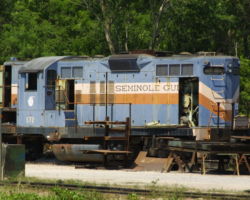




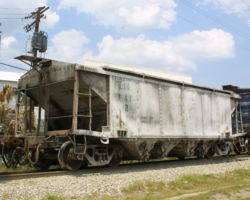
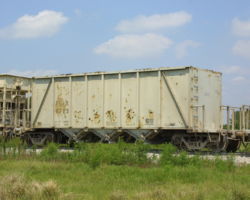
The Key West Extension

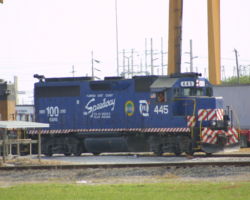



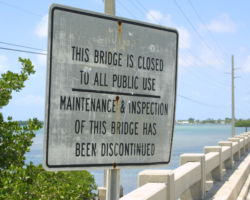
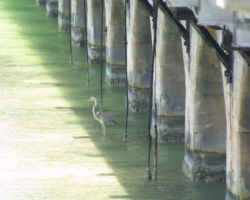
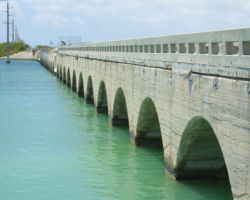
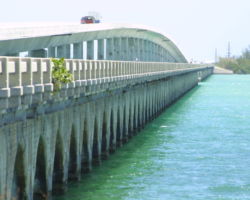
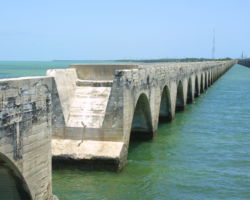

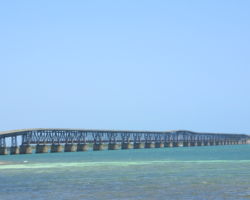
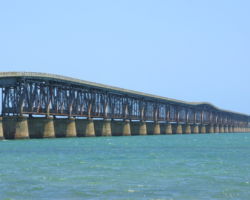





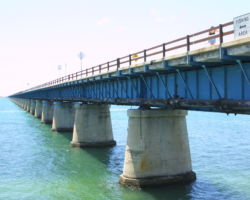

Alaska – Part 1, May 20-22, 2002 – Anchorage to Seward
I last visited Alaska in 1989 with my parents (as I was only about 13 at the time), and have wanted to go back ever since. Absolute have to love the place – wide open spaces, eighteen hours of sunlight, wildlife everywhere, a very interesting regional railroad, and, best of all, a very sparse population. Despite FedEx having a major hub in Anchorage, my efforts to convince work that we should do software rollout and testing in Anchorage had failed miserably. Eventually I just decided it would make a great destination for this year’s vacation, and sometime in April I convinced my wife of this as well.
Before heading out for Anchorage, it was back to Iowa for her brother’s graduation – and what better way from Denver, CO, to Galesburg, IL, than the eastbound California Zephyr, Amtrak 6? It turned out to be probably my least favorite Amtrak trip yet, despite being one of the few where I’ve actually had a sleeping compartment. Once the train was underway in California, a quick run of Amtrak’s P42s through UP’s Public Trace revealed what was powering the train. I knew it was a bad sign when the train was practically hemorraging time all the way across Nevada, Utah, and Colorado, so I didn’t hold out great hopes for an on-time departure from Denver. Sure enough, after getting stuck in Denver Tech Center traffic for nearly an hour, we arrived at Denver Union only to discover even Amtrak was guessing it would be an hour late.
Anyone familiar with Amtrak arrival estimates on late trains knows to automatically add 30-60 minutes. That meant that a train arriving at 2030h Amtrak time would really arrive somewhere between 2100h and 2130h, if not later. I think by the time they’d switched out the USPS freight on the back end of 6 and finally gotten the passengers loaded on and off, we finally departed around 2115h. I’d hoped that they would realize Denver passengers were expecting dinner, but apparently not – the dining car was closed and cleaned for the night by the time we were underway. So obviously an acceptable substitute involved sending us down to the snack lounge to pick out whatever we wanted to eat. While my microwavable pot roast was actually surprisingly good, it wasn’t what I’d expected.
Aside from our car porter, who was exceptionally friendly and professional, the rest of the staff seemed rather surly. The food definitely went downhill from two years ago, with the advent of the new “common menu” between all trains. The new meals-on-styrofoam plates didn’t seem to sit well with me – french toast with not-so-real not-actually-maple not-actually-syrup didn’t help, either. That all said, though, it still beats driving or flying – I can’t sleep on planes (not a nervous passenger, just can’t sleep sitting up in a cattle car environment), and driving almost requires a stop mid-trip. While I know Amtrak will offer vouchers based on their complete satisfaction program, somehow that would just feel like taking money from a dead man’s wallet. Amtrak has enough problems without its loyal supporters digging into its profits. All said and done, we pulled into Galesburg, IL, about 110 minutes late. (Photo #53, courtesy Celeste Holmes, better known as mom)
We left the Quad Cities on Monday, 20-May-2002, to fly out of O’Hare. The US air travel system makes it a royal pain if you want to leave from one city but come back to another. One-way fares are two to three times that of a round trip ticket. Fortunately, DEN (Denver, CO) and ORD (O’Hare, Chicago, IL) are both major United hubs, and we found a flight when planning the trip that had a plane change in Denver. Worked great for the trip out, since we got to fly out of Chicago to Anchorage, and on the way back we’d just never board the DEN-ORD segment of the flight. The only possible problem was getting the luggage home – it’s a good thing we both work for FedEx, makes shipping it home a whole lot cheaper. So, two round trip tickets from ORD to ANC, please!
Michelle and I arrived in Anchorage late (about 2030h) on Monday, 20-May-2002. One of the first things we noticed was that Anchorage was nearly 10 degrees warmer than Chicago! We claimed our luggage and picked up the rental car. Thankfully this was personal travel, not corporate, so I could actually get a comfortable vehicle without worrying what the company would pay for and what they wouldn’t. In this case, it turned out to be a red 2002 Ford Explorer. I’m not usually a big Ford fan, but like the Escape, I really grew to like the truck.
While the vacation was rather free-form in plan, the hotels were already reserved a month in advance. (Note: Lodging in Alaska fills up quickly with so many tourists in so little time – for anyone going, reserve early! I didn’t even get many choices I wanted for the first stretch in Anchorage, nearly everything was full.) The plan was three nights in Anchorage, then one near Denali, one in Fairbanks, and back to Anchorage for a few more days, flying home on 28-May. The only reason I put so much time in Anchorage was that it was within a day’s drive of quite a few things, and would give us the most flexibility with the very limited time we had. First stop, though, was the hotel for the first four days – the Anchorage Econolodge, one of the few places that had openings all three nights. For those railfans thinking of where to stay in Anchorage, think Comfort Inn Ship Creek. The Econolodge is definitely not that great – noisy (southbound Seward Hwy runs right along the east wall), expensive, and quite a ways from the rail yard.
After checking in and unloading the luggage, I headed down to the yard to have a look around. As luck would have it, the southbound Denali Star (the daily passenger run from Fairbanks to Anchorage) had arrived a few minutes earlier, and ARR 4002 and 3009 were sitting in the evening sunlight. (Photo #54) Too tired from crossing four time zones in four days, I headed back to the motel after that to try and get some sleep. Unfortunately, that whole 18 hours of sunlight thing decided to interfere, and with the window in the room having no opaque shades, sleep didn’t come easily.
May 21 was mainly a day to recover from travel and do some sightseeing around Anchorage. Since I didn’t sleep particularly well, the day got off to a very early start (0600h). I headed down to catch the morning Anchorage-Seward train about 0640h, and finally found a spot I was somewhat happy with down on what I believe was Stolt Lane between W 8th Street and W 10th Street. It still took standing on the back of the Explorer to see over the fence, but I was very surprised at the resulting shots. (Photo #55) After that, I headed back to the motel to pick up Michelle, and after catching the northbound Denali/Fairbanks train (last night’s train turned to head north) sitting at the Anchorage depot (Photo #56), we headed east out of town towards Palmer and eventually, Glenallen.
Palmer yielded the second and third trains of the day – loaded gravel trains (Photo #57) getting ready to head south to Anchorage as soon as the northbound Fairbanks passenger train was through. As I understand, these trains typically leave Anchorage in the early morning hours (0100h or so), head out to the gravel pits and load, and then return to Anchorage in the late morning for unloading. Somewhere after noon, the whole process repeats for a second run. This was the last time I made it out to see a gravel train at Palmer – every other day I had the morning available, they either weren’t running or it was too late and they’d already headed back for Anchroage.
From Palmer, we were headed east towards Glenallen, away from the railroad. I’d promised Michelle I wouldn’t monopolize the entire vacation railfanning, so I didn’t wait around for the gravel trains to move. Instead, we headed out east to look at the mountains, glaciers, and a bit of wildlife. Since you’re probably not all that interested in every detail of my vacation, I’ll skip that part. Aside from some moose, musk ox, Dall sheep, and various other varmits, I didn’t photograph much else on Tuesday. After arriving back at Anchorage in the late afternoon, we headed back to the hotel for a bit. On the way in, though, I heard a northbound mixed getting ready to leave the yard. So, I dropped Michelle off at the hotel (headache, wanted to get off the road) and headed north to the first really easily accessible spot north of Anchorage – the road to the Birchwood airport. A short time later, ARR 4012 and 4001 showed up with the train in tow. (Photo #58) Later that evening, after dinner I went down to see the meet between the returning Whittier train (on schedule at 2130h) and the arriving, very late, southbound Denali Star down at the depot. (Photos #59-61)
On Wednesday, May 22nd, we decided to head down towards Seward for the day after catching the northbound Denali Star at Anchorage (Photo #62 – hey, we’re already there, why not catch it?). It worked out just fine for me – we both were interested in the Alaska Sealife Center (since we both wanted to see some of the wildlife in and around Resurrection Bay, but I was unwilling to spend half a boat trip motion sick in the ship’s head – bad memories from last time) and I could easily railfan along the way from Anchorage down the Turnagain Arm. The entire trip down was relatively uneventful, as we were too far behind the Seward train and too far ahead of the Whittier one. No freight in sight, either. While the weather in Anchorage was good, it deteriorated quickly as we went south, to the point that it as 60 degrees and raining over Moose Pass. The only thing that looked promising was a long bridge over the Snow River, about 12-15 miles north of Seward. However, based on the time, I assumed we’d already missed the southbound passenger train.
Wrong. Amazingly enough, thanks to the large stretches of 65 mph on the Seward highway and the Seward train running slightly behind, we were actually able to make it into Seward ahead of the train. I didn’t realize this, though, until we got to Seward. After roaming around a bit, we headed back towards the depot to look for lunch. Just as we could see the depot, the distinctive light package of an ARR GP40-2 pulled around the corner. (Photo #63) I photographed it, and then gave in to my stomach and went to get some lunch – which turned out to be fish and chips from a local place down on the dock.
A few hours later, after we’d taken in Seward and the Sealife Center, I caught the train once more (having been wyed in the time in between – Photo #64) and we headed back to Portage. At this point it was about 1500h or so, and it seemed a waste of the afternoon to just go straight back to Anchorage. Since I’d never seen Whittier, we decided we’d head out that way before returning to the motel. Whittier was connected into the ARR system during WWII, as a backup year-round deep sea port to Seward. Today, it’s the ARR’s primary connection to the outside world. The rail barges from the lower 48 interchange all traffic through the Whittier barge slip, making it a vital piece of the ARR system. (Seward has fallen oddly silent as a port lately, since the discontinuation of the Healy-Seward coal trains.)
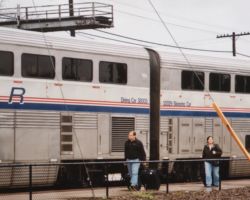
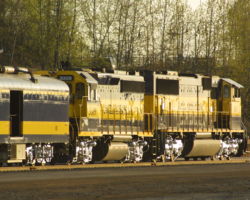


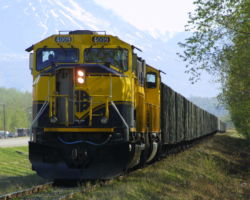


Alaska – Part 2, May 22-23, 2002 – Anchorage, Whittier, Denali
Up until a couple years ago, Whittier was disconnected from the rest of the Alaska highway system. The only way to get in or out via car was either to use the Alaska Marine Highway (a very large euphamism for an ocean-going ferry connecting various AK coastal cities and the lower 48) or via the ARR’s shuttle trains through the railroad tunnel. Back in 1998, though, the government let a contract (some would say got hoodwinked to the tune of $80ish million) for the conversion of the ARR’s tunnel to a dual-mode facility – road and rail traffic through the same tunnel (though only one direction of one mode at a time). The tunnel is controlled from portals/staging areas on both ends, and road traffic reverses roughly every half hour. Being late in the day, I got there at the end of a Portage-to-Whittier cycle and had the tunnel basically to myself after paying the $20 toll (since reduced to $12). Needless to say, while I didn’t stop, I managed to grab a few views of the tunnel interior, looking out my windshield. (Photo #65) For more information, see the Alaska DOT’s Anton Anderson Memorial Tunnel page.
Whittier, like most every day, was covered with low-hanging clouds and the occasional spat of drizzling rain. Not any great deluge, but as I understand this is typical Whittier weather, even if Portage is sunny. Whittier isn’t exactly much of a town anymore. There’s a small tourist industry (mostly focused around the fishing and boat sightseeing), the local boating/fishing industry, and obviously the railroad dock, but I’m not quite sure what else anyone does. Everyone seems to live in one of the two pseudo-high rises that I believe used to be military housing (and everything else needed for normal life – as John Combs puts it, “a city in a box” The second, abandoned building is visible behind the next two photos.) I suppose that will change now that the highway is connected, but in the meantime it’s an interesting little town.
The most prominent piece of rail equipment in Whittier while I was there was, of course, the tiny Anchorage-Whittier train. (Photo #66) I’m not certain, but it appears that the ARR also keeps some power in Whittier to do local work and switch the barge slip. When I was there, the power in question were GP40-2s 3002 and 3006 (Photo #67), both in the black and yellow scheme. They weren’t actually doing anything, just idling deep inside the yard awaiting a crew and a task. There was also barge in the slip while I was there, and they were working with the containers on the top. These giant green rail barges have rails underneath for conventional cars, and then a superstructure over the top that holds several levels of containers. It does certainly seem more efficient than moving all the railroad hardware associated with normal cars (trucks, couplers, etc.) back and forth to the Pacific Northwest every time for loads that can be intermodal containers.
After missing the westbound tunnel cycle, we wound up waiting for nearly half an hour at the Whittier tunnel mouth for the direction to once again reverse. Passing back through the tunnel (there is no toll from Whittier back to Portage), I was the first in line and as such had a whole string of cars behind me. Not much chance to get any more photos, now that I’d actually had time to set up the camera for shooting pictures inside a deep, dark hole.
After driving back to the main highway from the Bear Valley and the tunnel, I was pleasantly surprised to find the clouds thinning a bit and three locomotives in the hole at Portage. ARR 3009, 2002, and 4014 were sitting there waiting for… something. (Photo #68) With no chatter on the scanner and no crew in sight, I got my photos and headed back for Anchorage, stopping for dinner at Chair Five (and ice cream later on) in Girdwood. From there, it was getting late and starting to rain again, so we headed back to Anchorage and the motel, with a brief stop to look at a few bald eagles along the way.
Thursday, 23 May, was more or less a travel day between Anchorage and Denali. My wife wanted to sleep in a bit, and as usual I couldn’t sleep so I headed down towards the station to hopefully catch something. What day in Anchorage would be truly complete without going down to see at least part of the gaggle of trains leave in the morning? However, to my surprise, the three units that were tied down at Palmer the previous night were just starting to be turned north of the station. The yard lead, the track to the docks, and the line connecting both to the mainline west of the depot form a very useful wye with a long tail track (the entire distance back to the docks). The best part is that two legs of the wye cross a public road and there is public parking a very short walk away. The whole thing was quick and very easy to watch. (Photos #69-70)
All in all, the trip to Denali was relatively uneventful. Unlike my first trip to Alaska, it was a nice clear day the entire way and Mt. McKinley was actually not hidden in a bank of clouds. Yes, I did actually get photos of it – what, did you think all 1500+ photos from Alaska were ARR related?
Somewhere south of Cantwell I heard a meet being arranged between a northbound freight and the now quite late southbound Denali Star. Originally I believe the idea was to make the meet at Cantwell, but at some point the dispatcher changed his mind and moved it to Windy, the next siding north. By the time I arrived, the meet was already underway and the freight was creeping up to the end of the siding preparing to depart. As a hint to future ARR fans – Windy is a lousy photo opportunity – the track is 1/2 to 3/4 of a mile away on the opposite side of Jack and Nenana Rivers, and in the afternoon the light is entirely wrong. Giving up after a few more scenery shots, we thought we’d catch the train closer to the national park itself.
Summer light in Alaska is wierd. Unlike in the Lower 48 that most of us are used to, it seems to start in the northeastern sky, gets pretty high in the southern sky during mid-day, and then return to the northwestern sky in the evening. At least that’s how it seemed, and my feeble little brain is convinced that actually makes sense based on the tilt of the earth, rotation, and the incident angle of incoming light. I think… but that’s certainly what it seemed like to me while I was up there. Either way, by the time the train and I finally both made it to the crossing on McKinley Park Road, the sun was planted firmly behind it in the otherwise hazy but blue sky, making for an extremely difficult setup. For those planning on railfanning this section, there’s a parking lot right next to the grade crossing here, and I never had problems finding a space.
No sooner was I out of the truck and had my shot somewhat set up, than I had another tourist telling me that this line was just for the tourist trains and it had already passed for the day, (Neither of which point was true, obviously… What is it, do I just naturally attract these people? It seems like I get to hear from these informed people all the time.) I believe his parting words were, “Enjoy the wait, but nothing’s coming.” No sooner had he wandered off down the trail than 4016 poked out from around the corner with a full train of military equipment and empty oil tankers. Or maybe it was just my imagination playing tricks on me, though for a figment of my imagination it had some nasty lens flare… (Photo #71)
That taken care of, we went over to check into our hotel for the night (Denali Princess Lodge) and do some actual sightseeing and touristing. Normally I don’t comment on roadside fare and accomodation, but on this trip there were those that were particularly good, and those that were very notably bad. From the looks of it, this was going to be one of the notably good ones. After all, what could be wrong with a resort hotel run by a noted cruise line overlooking the Nenana River canyon? Oh, I’d have to say darn near everything. Sorry Princess, but I call ’em as I see ’em.
I have to say the resort itself is esthetically beautiful, and in an absolutely grand location. The rooms, while a bit pricey, are nice, and I got one with a river side view. From there, it was peaceful and otherwise beautiful with a view out onto not only the river, but the railway pearched high above on the opposite canyon wall. What follows is everything that can go wrong, and will, in paradise. If you don’t want to listen to me rant, skip down two paragraphs.
Lunch quickly changed my viewpoint on the place. Being a resort-type place, there were several eating establishments around the property. Since it was rather late for lunch (around 1430h), we decided to just go grab some burgers at the bar and grill place (I don’t remember the name of it offhand, because by the time you finish reading this, it won’t matter). Well, first shocker – burgers were about $9-something, as I recall. High prices at tourist places in Alaska are not uncommon, though – everything has to be brought in, and all the money has to be made in a very short season. So we ordered from a selection of about 5-6 meal combos and and sat down, complete with a little plastic number sign that you’d expect from, say, some fast food joint. Okay, not great, but I’ve never judged a place by appearance – I eat in lots of unremarkable little dives with great food. This, however, will not be one of them. My burger arrived the first time with no cheese (and as I’d paid something extra to get it, on top of the richly-priced burger itself, I was going to get one way or the other), and once I’d hauled it up and given it back, it took something like five minutes to get the damned thing back with a slice of cheese on top. In the meantime, I think it was just sitting and waiting for attention, as it came back not quite so warm, slightly undercooked, and with a very cold slice of cheese on top. So what exactly here took five minutes? Not only that, but I’d rate the quality of the burger patty in question as medium to low – it left me asking, “Where’s the beef?” much like the cafeteria at work.
Skipping ahead a few hours and over the railfanning, dinner at the main restaurant was similarly disappointing and overpriced. While at least mine that time was decent, Michelle’s Thai chicken left a very great deal to be desired – overcooked to the point of toughness. All that and more for the low, low price of $50. *tearing my hair out – why didn’t I go to the bar down the road?* Add to that the fact my wife left my favorite black FedEx jacket hanging in the entertainment center beside the TV in the room. Okay, that much is my fault – my wife hid it from me and I never thought to look for it there. Despite calling them promptly the next day, there was pretty much no sign of it, and I had the worst time even getting someone at the front desk to take any action other than writing a report for security to look through lost and found, sometimes even getting to that took effort. The usual party line was, “Nope, it’s not in the lost and found, we don’t have it.” Look, I know what room I left it in, exactly where it was left behind and can describe it right down to the address labels I keep in the ripped right pocket that have my name on them, why can’t you do something? If it’s not in the room (which I’m not sure was ever checked), you know who cleaned the room, put some pressure on them after I dumped $200 at your lousy hotel. As I said, I normally don’t comment on the bad establishments, but this one has me royally torqued to the point that I’m going to let the roughly 1500+ hits I’ll get to this trip report know exactly what I think. Make up your own mind, but I can’t stress strongly enough how much I do not recommend staying there.
Okay, now back to railfanning. (If you’ve actually read the above rantings and ravings of a lunatic, then this falls somewhere between the disasters of lunch and dinner, otherwise just assume it happed roughly after checkin.) After our rather horrid experience with lunch, we went out and looked around for a bit to see the area and hopefully find wildlife – anything. We hadn’t even seen our daily moose yet for Thursday. We never did find anything, and eventually we decided to go back and relax as best we could at the resort. Might as well get something for our money.
I probably hung around the area for fifteen minutes before I heard the northbound Denali Star pull into the station at the park. Normally that wouldn’t have interested me that much – I’d seen that train and its power before, and climbing back in the car just wasn’t appealing to me. However, just out of curiousity, I flipped on the scanner and heard the DS setting up a meet with a southbound OX (Oil Express) train at Healy, just a few miles north of the park. The best part was that Garner Tunnel and the so-called Million Dollar Curve lie in the section between Denali and Healy. A northbound doesn’t make for a decent shot through here (except possibly coming around MDC in the morning), but a southbound would fit in just perfectly that afternoon. In addition, it gave me a chance to photograph an actual ARR freight on the road, and an excuse to go explore Healy.
Before the expiration of the South Korean coal contract in mid-May (the last run being some time around the 15th, I believe), the mines east of Healy were the source for a very regular coal run to Seward for loading onto ships. However, apparently Australia has started dumping cheap coal on the market, and no new contract could be negotiated. Thus, the Alaska RR is now without one of the runs that’s been a hallmark for the last decade, and a fair number of mine employees in Healy are out of their jobs. As I understand it, Usibelli is still providing coal to the generating station in Fairbanks (and I did see five or so cars get spotted and unloaded the next day), but I’m not sure if this is enough revenue to sustain operations.
After looking around Healy for a bit (I heard the southbound OX call in from nearly 15 miles away, and it was supposed to be there first), I parked my truck on a side road and walked up to the top of the highway bridge over the north end of the yard. For reference, take the only road into Healy from the Parks Highway – you can’t possibly miss the overpass. After learning (the hard way) not to sit on the creosote-coated guardrail supports during hot weather and getting lots of inquisitive looks from passing cars, the southbound showed up creeping around the corner (Photo #72) and slowed to a stop before the switch. (Photo #73) One man got out, lined them into the hole, and waited for an ARR Suburban to show up for a crew change.
Only a few minutes later, the northbound passenger train arrived and shot through Healy with amazing speed (Photo #74). After watching the southbound creep around the yard, something moving so quick halfway caught me by surprise. The crew van did some shuffling of personnel, and I interpreted that as a good sign that the train would soon be underway. Not wanting it to get that far ahead of me and really needing fuel, I decided to leave before it actually got underway.
I stopped for fuel (and somthing to drink) at the gas station between the Healy road junction and the Nenana bridge, keeping my scanner on the whole time. While I heard quite a bit of chatter, nothing much was yet mentioned about departure. Finally, just as I was climbing back in the truck, I heard something about 4005 departing Healy, so I decided to get going and hope to beat it by enough to get the train popping out of Garner Tunnel.
For those unfamiliar with the Garner/Parks Hwy Nenana bridge area, there’s a parking area at the southwest end of the bridge. From there, there’s a small trail leading back through the trees that will give you an excellent view at the tunnel looking slightly under the bridge. Of course if you walk too far, you’ll fall off the cliff, but that’s another issue entirely. So here I sat, for what seemed like an endless period of time – eventually something along the lines of nearly an hour. After the first half hour, I thought I’d missed the train somehow during my stop for fuel, but everything I could figure about timing from Healy to Garner told me that wasn’t right. Finally, about 40 minutes into the wait, the reason was uncovered – one of the men riding in the caboose spotted either a broken rail or a broken angle bar after the train had passed over it, and they were stopped to inspect it. At that point, they had a maintenance gang on site and the joint was being repaired – at last things could continue.
Sure enough, a few minutes later the train popped out of the tunnel and under the bridge – a shot I’d first tried on my first Alaska trip 13 years ago (and failed miserably that time). This time, it became Photo #75. I followed it back down the canyon, not really seeing any other well-lit locations with the sun rapidly dropping back over the mountains. However, the crossing on Mt. McKinley Road I’d used earlier in the day sits at the end of a break in the hills, and I thought it might provide a decent shot. So I headed back there, got the parking spot right next to the track, and waited. With a hiking trail right next to the line for a few hundred feet, there were random hikers and tourists wandering in and out of the shot. I was concerned that they’d be standing in my photo or, worse yet, wind up as a splatter, but I didn’t say much. The speed limit is only 10, and crews are well aware of all the pedestrians in the area. By the time the OX showed up, everyone else had departed and it was just the train, sunlight, the forest, and myself. (Photo #76) After that, I retired back to the resort for dinner and to actually spend time with the other half.


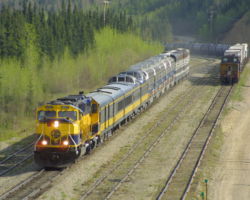
Alaska – Part 3, May 24-25, 2002 – Fairbanks and back to Anchorage
Friday the 24th of May broke early and sunny, but after the previous night’s experiences with eating we decided that something further up the road was definitely in order for breakfast or lunch, whichever might come first. By 0930h or so we were packed (well, except for my jacket, which decided to stay in the room), checked out, loaded up and heading out for points north. I know, one of these trips I should actually take a day and take the bus back into Denali, but this time was just going to be too short for the ground we both wanted to cover.
First stop for the day was Nenana, site of the completion of the ARR, a spectacular span over the Tanana River, and a depot with a semaphore. Offhand, I didn’t think I’d have much of a chance catching up with a train, so we just decided to do a little exploring around, photograph some of the town and the depot, visit the local tourist trap stores, and find some breakfast/lunch. Not encouraging me was the track crew working just east of the depot, doing various bits (including rail welding) apparently preparing to put in a new grade crossing (Photo #77). However, upon getting back in my truck I caught a bit on the track gang asking how much time was left before they’d have to clear up for the northbound. “Oh, about an hour or so.” Woohoo! Just enough time for lunch.
Per the Milepost, we decided to give the Rough Woods Inn a try. It’s just down the street from the depot, and it’s actually very good food. Strongly recommended if you’re looking for food in Nenana. (Figure I chewed out the resort last night in the previous section, we’ll try to put in a few positive plugs for places that were good.) Lunch took almost exactly the hour, and was extremely good without being overpriced. I was back out trackside just as the work crew was removing themselves from the main.
Not fifteen minutes later, 4011 and 4009 tripped the scanner just south of Nenana, telling me to get my big lazy rear to the east side of the station to set up the shot. Ever since seeing the depot, I wanted a shot with the train, depot, and signal all in it. As luck would have it, everything worked out near perfectly, and the resulting shot is Photo #78. Got waves from not only the operating engineer in the front cab, but another crewmember (or deadheading crew) in the trailing unit. With such beautiful sun and skies, I decided to try for another shot across the river since the train would be delayed by the climb to the bridge and the speed restriction in crossing.
Immediately after exiting the Parks Hwy bridge over the Tanana River going north, there’s a parking lot to the left and a dirt road to the right following the railway back towards the bridge. I parked the truck and walked back along the road to wait for 4011’s arrival. It didn’t take nearly as long as I’d anticipated, and about halfway to my shot I had to break out into a run to make it. I did get the shot I wanted, though (Photo #79). However, hustling back to the truck afterwards, I couldn’t figure out why my wife was laughing and holding the scanner. As it turns out, when the engineer had seen me again, he radioed back to the crew in the trailing cab, “Smile, you’re on candid camera again!” That’s one thing I’d picked up already about the ARR – they seem very fan-tolerant, if not downright friendly (presumably as long as you’re behaving yourself, anyway). I have to say it’s a nice change from the neutral to downright hostile response from the two big western roads in the lower 48.
After that stop, it was on to Fairbanks. I heard the DS set up another meet at Saulich, but as best I can tell Saulich is fairly hard to access without going up to Fairbanks and backtracking down forestry roads. Actually, at first, I couldn’t tell where the meet was planned. The scanner was breaking up when the warrants were given, and I remember asking my wife to look through the timetable for the first siding north of Nenana that looked roughly like sandwich (as you can tell, food is one of the driving forces in my mind). If someone knows a better way (or any way) to get there, let me know and I’ll include it so others can succeed where I grew apathetic and moved on. So on to Fairbanks it was, and we arrived in town a few minutes later.
One of the things that’s been high on her list of stuff to do was visit the museum at the University of Alaska Fairbanks, primarily wanting the see the exhibit on Japanese-Americans in Alaska during WWII – makes sense, considering she’s half Japanese-American and all. Not only was that quite interesting, but even the rest of the museum actually kept me interested for a few hours. Those who know me know I’m not a big fan of looking at non-industrial museums (my interest and emphasis has always been on industrial and technological history, not the more social, human aspects), but I found this one to be very well worth the time. Again, shameless plug for promoting things I enjoyed.
By this time, it was getting reasonably late in the day, probably about 1600h or so. We decided to go find the hotel and check in, look around Anchorage, and maybe find some dinner later on. Greeting us at the hotel were two moose that had wandered into town and now were just strolling down the road and around the parking lot, eating anything that looked appealing. While we’d seen plenty of moose already this trip, these two were by far the best shots and the closest. (Photo #80) Not something I’m used to seeing running around in an urban area, and certainly no more or less odd than large new AC power running on a small regional railroad. 🙂 Alaska’s just full of strange stuff.
As usual, after dinner and looking around town a bit more (and photographing 2001 sitting in the yard – Photo #81), Michelle wanted to head back to the motel to settle in for the night, and I wanted a shot of the incoming Denali Star by the semi-famous North End of the Main Line sign/bumper at the Fairbanks depot. So, back downtown I went, and waited, and waited, and waited… The northbound train was nearly two hours late arriving, and for some reason people waiting to pick up passengers thought the wandering railfan in the parking lot with the scanner should know something. No, everyone, I wish I did, but I don’t know any more than you do… Still, it gave me a chance to look around inside the depot at all the great posters the ARR has commissioned over the years. [Note: I’ll pay serious money for the 1996 print if anyone wants to sell] Finally, around 2240h, the northbound arrived under a great sunset (thanks to the nearby Chena Hot Springs forest fire – Photo #82). ARR 4010 as the lead unit was no surprise, but the second unit… an Amtrak F40PH, specifically AMTK 241, imported as lease power (and more importantly, a HEP generator) for at least the summer season. I’d heard that there were two F40s headed north, but this was the first one I’d seen.
After stopping to drop the cruise line cars the bring up the rear of every one of these trains, the normal ARR segment pulled forward into the depot. Unfortunately, with failing light and the angle never being quite perfect, I never got 4010 with the end of the main line sign. However, as soon as it stopped, the Men Working blue flags went up and a small crew tended to the usual care and feeding of the units in preparation for the next day’s run. (Photo #83) With that, I called it a night.
The next morning (Saturday, 25-May) we decided to go out to Fox to get a look at the Alyeska Pipeline, since obviously Michelle hadn’t ever seen it. However, before we even got through Fairbanks I looked back to see headlights coming out of the yard. It hit me pretty much instantly – a local headed out to North Pole! I’d hoped to catch one of these jobs, just to see one, and without even trying I managed to do it. I’d found a spot the previous night several blocks east of the Steese Highway on Trainor Gate Road (don’t go too far, though, or you’ll find yourself at a security checkpoint for Fort Wainwright AFB). I pulled over and got my shot set up at what I think was the corner of E Street and Trainor Gate, and the local was soon there as well. Just as I’d finished with the last shot I’d wanted (Photo #84), I noticed the engineer holding up something, and saw it hit the ground a few feet ahead of me. When I picked it up, it was an ARR pin with a small version of the latest year’s print on it. Wow – you never get this sort of reception where I’m from. I don’t even know who he was, but if anybody knows the man in charge of that day’s run, please give him a big thanks from a very appreciative railfan. If, by some odd chance you happen to read this, drop me an email.
As a note, it couldn’t have happened with better timing, either – I’d been a bit down with the warnings coming out the day before about possible terrorist attacks on the US rail system and telling people to report in anything suspicious. All I could think was that the fan community would be further denounced by the industry, and that the general public would probably start calling me in as a suspicious character. Just what I didn’t need. Somehow that helped knowing at least one professional railroader wasn’t annoyed by my presence – thanks a million.
After that, the line enters Ft. Wainwright for some distance, and I really didn’t have that much inclination to follow it. There were other things to see and do, so I let the local get away after that. After a visit to the pipeline at Fox and a stop at the Fairbanks Farmers Market, we started in on the long journey back to Anchorage. Having 18 hours of daylight every day does make those long drives less daunting, though. Between the long days and the 65 mph speed limits on many parts of the Parks Highway, Fairbanks to Anchorage straight through is a leasurely day’s drive.
Thinking back, we probably got underway somewhere around 1100h or so, and stopped in Healy for lunch for about an hour. The scanner was all but quiet until we were just south of Cantwell, and then, out of the blue, I heard a detector go off for what had to be the northbound Denali Star (based on the time of day and location). So, in order to kill two of the proverbial birds with a single stop, I pulled over at the solar/wind-powered grade crossing near Summit. These crossings are completely off the main power grid and are powered of rechargable batteries. The cells are recharged from either solar panels during the daylight hours (summer is probably good, winter not so much) or from wind turbines whenever there’s adequate air movement. I’d been meaning to get a few photos of these ever since I first learned that they existed, but hadn’t actually stopped to do it. This just turned out to be a good excuse to actually stop and do it (Photo #85). Just a few minutes later, the northbound Denali Star appeared, powered by ARR 4002 and the other leased Amtrak unit – F40PH 245 (Photo #86).
With the northbound now past and the southbound still miles ahead of us, on down the road we went. Based on scanner conversations, I thought I’d try to catch it during the station stop in Talkeetna, but upon arriving it was already occupying the crossing and accelerating towards Anchorage. So, after looking around for a bit and stopping for gas back at the junction with the Parks Hwy, we were headed for Anchorage once again – and then I heard the meet at Willow set up. While both the dispatcher and the northbound train came in clearly, my somewhat panic-stricken brain didn’t think of that. In my mind, we were already south of Willow and needed to do some serious backtracking to get set up before the northbound was out of the hole.
As it turns out, we were actually just north of Willow, by about a mile. Without the GPS on, however, I was relying on my brain to keep track of exactly where we were – a job it doesn’t do well when it’s thinking about other stuff. So, we passed north almost 10 miles, and finally found a crossroad just south of Caswell with nice large gravel areas near the tracks. A very good shooting location, if a but north of where I’d actually intended. Since we had put a good deal of time between us and the train, Michelle used the opportunity for a quick walk around while I half-napped. About 20 minutes later the northbound arrived, mainly empty oil tankers with a little mixed freight, and lead by 4007, an SD70MAC I hadn’t seen yet. (Photo #87) And that, folks, is what we’ll call a day.


Alaska – Part 4, May 26-28, 2002 – Anchorage and the Turnagain Arm
Sunday, 26 May, was more or less given to me as a railfanning day. My wife wanted to get off the road and look around downtown Anchorage, so I got the Explorer and a good chunk of the day to go railfan the Turnagain Arm. However, no railfan day would be complete in Anchorage without watching at least part of the morning parade of outbound passenger trains. I decided to head down towards the depot just in time for the southbound Whittier train that I intended to follow down the Arm. However, to my surprise, there was an empty ballast train lead by a pair of the older black and yellow GP40-2s (3007 and 3004, to be exact) being turned on the wye just north of the depot. As two legs of the wye cross a public road and are fairly tight corners, the whole thing was quite slow and easy to watch. (Photo #88)
While watching the whole wying operation, I’d noticed that the Whittier local left the station. I didn’t think it would be a big deal, as the line isn’t really accessible for photography until Potter, almost 15 miles south of the depot. With track speed being around 30 and highway speeds being around 65, I wasn’t at all worried. As it turned out, I headed south and by the time I hit the first photo location I liked (a curve near Rainbow), I was nearly 20 minutes ahead of the train. So I went out on the point, sat down, and enjoyed the morning weather.
Before the train even showed up, though, things got more interesting. Even while out enjoying the great outdoors and waiting on the train, it would just be dumb to leave the scanner in the truck. I was quite glad I had brought it out when the dispatcher set up a meet between 3009 south and 3015 north at Indian, just a few miles south of my position. Based on speeds and distances, I figured I could catch 3009 here, then run south to Indian and catch the meet. But the real question here – what was 3015 north? 3015 is a HEP-equipped passenger unit. It seemed an unlikely choice for freight power during tourist season.
I caught 3009 rounding a curve near Rainbow (Photo #89) and then headed south to Indian to set up the shot there. I knew it was going to be tough, as everything’s running northwest-southeast at this point and the sun would be difficult to deal with down at the siding from the road side of the tracks. (As a note, there’s not much area on the opposite side of the tracks, and the mud flats are very dangerous for those unfamiliar with them. Apparently the mud in places is a quicksand-like material that either drowns you itself or holds you until the tide comes in and kills you. Did I mention stay off the mud flats?) Nevertheless, I found a spot sitting on the highway guardrail where the lighting was decent, and got Photo #90.
Within five minutes or so, I could see a headlight further down the sound – must be 3015 north. 3009 had already lined the north switch for mainline movement, so 3015 didn’t even have to stop. There’s a parking area near the north switch (on the opposite side of the road), so I pulled off there and shot the meet across the mudflats (Photo #91) and then 3015 alone as it continued north (Photo #92). Interestingly enough, I wasn’t the only person photographing it – there was also a woman with a camera and her kids, who all showed up a few minutes after I did.
The other odd thing was that I wasn’t expecting this passenger run at all. As I found out later, this is often called the “Grandview” and is an unpublished run made especially for the cruise line companies. It comes north from Seward (or, apparently, sometimes Whittier) to Anchorage about two-three times a week, waits an hour or two, and turns around to take the passengers back to their cruise ship. These cars were purchased from the Florida Fun Train when it shut down in the late 1990s. John Combs has more about it on his website. One of the railfan highlights of seeing this train was Alaska P-30, an E9B that was was very recently converted to have Blomberg-B trucks instead and provides head-end power for the train itself. (Photo #93) Very interesting-looking train, and a great unexpected surprise.
On the way back to the truck, I heard another interesting note – the dispatcher told 3009 that the freight at Portage would have the switch lined for Whittier by the time they arrived. So, that obviously meant there was yet another train down the inlet working north. Much more traffic than I expected to see on a Sunday, but perhaps with the next day being Memorial Day it had pushed some of the operations up by a day or so. Still, I had all the section between Indian and Portage to continue photographing 3009, and with the clouds building to the south I wasn’t going to waste any sunny opportunity. Once the sun switches sides around noon, there are several good opportunities in front of sheer rock faces close to Girdwood as the road crosses over to the west side of the line. (Some of these shots are included in the next section as just more ARR photos. I really ran out of space in this section.)
The last good sunlight of the day came just north of Portage, where I caught 3009 for one last time. After Portage, the line diverges for the short branch to Whittier, and is not easily accessed by road (except where it shares the road with the tunnel, obviously). There’s a road north of the Twentymile River bridge that leads down to an area beside the end of the bridge. Several great views are available from this road, including one of southbound trains (Photo #94) and of northbounds crossing the bridge.
Speaking of northbounds, sitting right across the river were ARR 2801 and 2807 on a northbound mixed. After nearly a week in Alaska, these were the first two GP49s I’d seen for the trip. I drove down along the Portage junction area to get a few roster and side shots of the units. It seems to be a semi-public lot, with a tourist information shack and the whole bit. I’m guessing this is where the Whittier Shuttle used to get loaded and unloaded. Only a few minutes after the passenger train was down the Whittier Branch and had cleared his warrant, 2801’s crew completed their air test and were underway northbound (Photo #95)
As you can see by the photos, the quality of light went downhill quickly. In all honestly, the last shot of 3009 was caught during a lucky cloudbreak. While the skies back towards Anchorage were clear, the clouds seem to build in the mountains above Portage and then spread to cover the entire Turnagain Arm area. The clouds and haze make for a very bright sky to shoot against, making blowing out the sky very easy. Still, looking in my rearview mirror I did see a few opportunities between Portage and Girdwood (Photo #96). Through this section the track winds around quite a few freshwater lakes formed (I believe) by the highway creating spaces between the hillside and the ocean rip-rap wall.
I needed fuel, so I stopped briefly in Girdwood, and then drove north to set up a shot while the road was still on the right side of the line for afternoon photography. It’s pretty easy, as there’s a parking lot here on the ocean side and plenty of space between the highway and railway to stand and photograph (Photo #97). Just try not to get run over by passing traffic – they do indeed drive like mad out on that stretch of Seward Highway. With that shot down, I’d decided with the poor lighting it wasn’t worth shooting anymore until I got back to Anchorage, so on down the road I went.
It took me until almost Rainbow to realize I was being dumb – passing up any more opportunities to photograph a freight train on the Arm, something I hadn’t ever seen before and probably wouldn’t get to see again for some time. Even a bad shot is worth something, especially when it’s just digital and not even costing me a penny. So, round and round we go, back to a place I’d seen earlier but hadn’t thought of using to set up a shot – a large rock outcropping that both the highway and railway cut through. It’s somewhere between Indian and Rainbow and has a decent area to park in, but the worst part is I don’t remember the name of the place, if it even has one.
When I got back there, there were Dall sheep up on the rocks, and I darn near missed the train coming around the corner because I was watching them feed and move around. How exactly those guys stick to the rocks I’m not sure. I can barely hold my footing in a large, perfectly flat asphalt parking lot (did I mention that I’m inherently clumsy?), and these little guys can move about on near vertical cliffs. While watching one with a large, curly set of horns standing on an outcropping, I heard horns of another variety entirely coming from behind me. So, I swung around and with little to no preparation, grabbed a set of shots. One of these became Photo #98. Note the tide is out and the mudflats that form the bottom of the ocean here are visible along the base of the embankment rip-rap.
Further up the road towards Anchorage is a place called Beluga Point. Apparently whales are common visitors to the waters of the Arm, and this (as I understand it) is a good place to look for them. In fact, while I was following 3009 south that morning somewhere around that area, the engineer radioed back to the train that he thought he’d spotted one. I never did see it, but then again I was also driving and trying to watch the train at the same time. Adding one more thing to look for was just getting challenging… Either way, it’s a nice sweeping curve with parking area off the road and easy access. It should work well for both morning and afternoon trains, and you might even get to see a whale or two if things work out correctly. (Photo #99)
I’d originally planned to follow 2801 back into Anchorage and then go pick up my abandoned wife, but plans got modified slightly when I heard that 2801 north would be going in the hole at Potter (Photo #100) for a southbound 3014. Now I thought the mystery of 3015 north at Indian was strange, but what on earth could 3014 south be? Another freight train? Either way, I had quite a bit of time to kill – as 2801 was taking the hole, 3014 was just leaving Anchorage and would take 30-40 minutes to reach Potter. Conveniently, Potter has a rotary snowplow on display (ex-Milwaukee X900212, purchansed by the ARR but never used) and a gift shop in an attached railcar. Not only that, but there’s a deck on the west side that offers an excellent view of the line. The snowplow is open for visitors, and I went inside for a look.
Once on the deck, I found myself talking to a couple of other tourists and the woman working the shop at the time. She was originally from Iowa and was now from Oregon. She’d only been on the job for a couple of days at that point, and was still picking up the whole process and tidbits about the ARR and the plow itself. Inside the shop were a whole variety of things, including one of the most interesting things I’d ever seen – new, wrapped copies of ARR Employee Timetable #129 for sale (130 is the current one, and is available as a PDF from the Alaska Railroad website under the employment section). Oddly enough, I’d learn later that my wife saw these for sale downtown as well – meaning that somehow the old ARR timetables are available for sale, probably from some semi-official channel, considering they were all brand new.
After a long wait (and purchasing a copy of Howard Clifford’s Alaska/Yukon Railroads: An Illustrated History, a somewhat new publication and one of the few books on far northern railroads I don’t already own), 3014 showed up southbound – with the mystery passenger train in tow. Apparently they’d dropped 3015 at Anchorage and replaced it with 3014 for the southbound run. (Photo #101) With that, I called it a day and headed back to Anchorage to pick up Michelle and figure out what we were doing with the rest of the day – and, of course, catch the southbound Denali Star after dinner.
The rest of the trip (Monday, and most of Tuesday) was spent looking around Anchorage and the surrounding environs, without a whole lot of railfanning. I caught what I could, but at that point I’d either resorted to being a normal tourist (Monday) or doing a little work over at the Anchorage FedEx hub (Tuesday). A couple parting thoughts on Anchorage: The Comfort Inn Ship Creek is quite possibly the best railfan hotel in Alaska, sitting right down on the flats between the mainline and the Anchorage yard. Not only that, but the fishing in nearby Ship Creek is also supposed to be very good (and I did see several people have some luck while I was there). Also, if you’re partial to good food and excellent microbrews, be sure to grab a bite to eat at the Snow Goose Restaurant. It’s not cheap, but I guarantee the atmosphere, food, and beer are all well worth it. Plus, it offers a great view out over the port and harbor in the evening hours.
Well, there it is – the largest, most mind-numbing trip report yet, from sea to shining sea, diagonally across North America. I hope you’ve enjoyed it, and hopefully you’ve found at least some small part of it useful. The Alaska Railroad is definitely an odd creature amongst regionals – over 500 miles of isolated mainline through some of the most remote country using some of the most modern, advanced EMD power ever created. Not only that, but whose employees and corporate mentality seem railfan-tolerant, if not friendly. Certainly if you go, enjoy Alaska and see as much as you can – but save a day or two for the ARR, as has a very different feel from anything you’re used to. Unless, of course, you already live in Alaska. 🙂 I’ll leave you with one more page of Alaska photos, and thanks for your attention.

Alaska Miscellaneous Photos


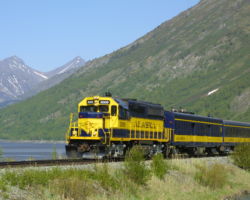








This work is copyright 2024 by Nathan D. Holmes, but all text and images are licensed and reusable under a Creative Commons Attribution-NonCommercial-ShareAlike license. Basically you’re welcome to use any of this as long as it’s not for commercial purposes, you credit me as the source, and you share any derivative works under the same license. I’d encourage others to consider similar licenses for their works.











































































